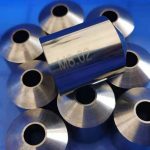In order to adapt to the situation, China’s mold industry has accelerated the pace of system reform and mechanism conversion in recent years. The “three capital” and private enterprises have taken the leading position in the industry, the equipment level and product level have been greatly improved, and the management has made great progress. . Many companies have applied CAD/CAM/CAE integration technology, three-dimensional design technology, information management technology such as ERP and IM3, as well as many high-tech technologies such as high-speed processing, rapid prototyping, virtual simulation and network technology. More and more companies have passed various quality system certifications.
1. Economic benefits of scale and rapid development of clusters
While the specialization of “small but specialized” continues to develop, in recent years, the scale effect has been paid more and more attention. In addition to making enterprises stronger and larger, and generating benefits from economies of scale, mold cluster production has also continued to show its superiority. Therefore, various cluster production forms such as “mold city”, “mold park”, and “mold production base” are in the country. Rapid development. At present, there are more than 40 companies with an annual output of more than 100 million yuan in molds, and more than 200 companies with more than 30 million yuan. There are nearly 50 “mold cities (parks)” with certain influence. The construction of these mold cluster production bases has played a positive role in promoting the development of China’s mold industry.
2. Attach importance to brand patents and strengthen innovative research and development
Many companies have begun to realize the importance of “brands” and “patents”, and their capital investment and capabilities for independent innovation have been continuously improved. For a long time, molds have been in a “rear” and “passive” position, so there are few “brands” and “patents”. With the development of the market economy, companies have paid more and more attention to “brands” and “patents” in recent years. Some companies have realized the importance of innovative research and development, and their investment has increased rapidly. According to the situation learned by the China Die & Mould Industry Association, in recent years, the ratio of investment in innovation and R&D to sales revenue of many companies has reached about 5%, and some companies have even reached 8% to 10%.
3. High-tech is popular, and mold talents are in short supply
The technical content of molds continues to increase, and there are more and more molds that are high-tech products. With the development of high and new technology, more and more mold manufacturing enterprises are recognized as high-tech enterprises by relevant government departments at all levels. According to the preliminary statistics of the China Mould Association, there are currently 7 national high-tech enterprises in the mould industry and nearly 100 provincial and municipal high-tech enterprises.
The shortage of talents has become increasingly prominent. Although the workforce of China’s mold industry has developed rapidly in recent years, it is estimated that it has reached nearly one million people, but it still cannot keep up with the development needs of the industry. First, the total amount is insufficient, and the second is the lack of quality to meet the needs of industry development. According to Luo Baihui’s survey, there is a shortage of 300,000 to 500,000 employees in the mold industry across the country, of which engineering and technical personnel account for about 20%. At present, high-quality and high-level mold enterprise management personnel, middle and high-level technical personnel and senior technical personnel are particularly in short supply. Worker.
4. The foreign trade deficit has increased and the export prospects are promising
Although China’s mold industry has entered the fast lane of development, it is still far behind the international level and advanced industrial countries in terms of accuracy, life, manufacturing cycle and capacity, so it cannot meet the needs of China’s manufacturing development. . Especially in terms of precision, large, complex, and long-life molds, the demand is still in short supply. Therefore, a large amount of imports are still needed every year.
The dependence on foreign investment has increased year by year. It has been six years since China joined the World Trade Organization. Foreign trade has developed rapidly. The dependence of China’s economy on foreign trade has risen from 30% to 70%. At the same time, in recent years, it has been a period when a large number of foreign capital has entered China. With the continuous expansion and deepening of the opening-up policy, foreign investment in China’s mold industry has also increased, resulting in an increase in dependence on foreign capital year by year. For example, Guangdong Province is the largest province in China for molds, and its production capacity accounts for about 40% of the country’s total. In the province’s mold production capacity, foreign-funded enterprises account for about 60%, and joint ventures account for about 10%. The province’s mold exports account for about 50% of the country’s total, of which foreign investment and joint ventures also account for the majority of its exports. The high degree of dependence on foreign capital and foreign trade will have a major impact on the safety of the industry and even the economic security of the entire country.
Link to this article:Five development trends of China's mold industry are optimistic about export prospects
Reprint Statement: If there are no special instructions, all articles on this site are original. Please indicate the source for reprinting:Mold Wiki,Thanks!^^

